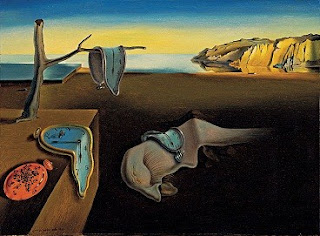 |
| The Son of Man -1964 |
The Son of Man (1964) was painted by Rene Magritte as a
method of depicting the real and hidden about human nature. The picture shows
an apple covering a man’s face with his eyes sticking out over the apple
watching the world. The left arm of the man bends backwards from the elbow
creating an unnatural body position. The sea in the back and the half height
wall all help to draw attention to the absurd. The picture being absurd only
because we cannot understand what the purpose is of something so blatantly in
front of us and designed to block our complete understanding.
The picture draws us to try and see the face so that we can
recognize who it is even though it has been confirmed to by the author to be a self-portrait. The apple being an apparent distortion of that
recognition that creates a level of frustration and conflict for the viewer.
There is almost a desire to knock the apple away to see who it is that is
peering out over the top. This frustration draws us to look for other clues in
the painting leading us to the half wall, the sea, and the clouds. None of
these appear to provide any apparent meaning. Yet they do create a context for
the work once its meaning has been discovered.
Some have argued that the apple is a sign of human nature
and that it is difficult for people to truly understand and recognize that
nature. The apple being from the original sin of man spawning from the Garden
of Eden while the blue ocean coming from heavenly divinity. In the picture it
is possible that the sight and nature of man is obscured from divinity. This could be one of the reasons why it is
labeled “Son of Man”.
According to Rene
Magritte in a 1965 radio discussion he states, “At least it (the apple) hides the face partly. Well, so you have the
apparent face, the apple, hiding the visible but hidden, the face of the
person. It’s something that happens constantly. Everything we see hides another
thing, we always want to see what is hidden by what we see. There is an
interest in that which is hidden and which the visible does not show us. This
interest can take the form of a quite intense feeling, a sort of conflict, one
might say, between the visible that is hidden and the visible that is present.”
According to this concept there is always something new
behind what is apparently in front of our face. What we see is not always all
there is in life or all that we need to know. That we keep seeking what is
hidden from use in order to understand its nature and the nature of ourselves.
Those things that block our sight create the frustration of not being
able to see and remove those objects that hinder our understanding. Is this the
nature of man? Is this the nature of original sin? Certainly one could make the
argument that the nature of man and his apparent ability to sin obscures our
view of the world and divinity.
Whatever conclusion scholars and lay people come to it is
apparent that the painting helps us feel something that draws our interest.
This is the very point of Rene Magritte and other surrealist painters. Such
painters view their paintings and writings as a philosophical movement with the
actual artistic works being artifacts of that effort. Originally based in Paris
France the war scattered the artists which spread their work into varying
industries. In modern times we can see their works in movies, music, and other
popular cultural expressions.
